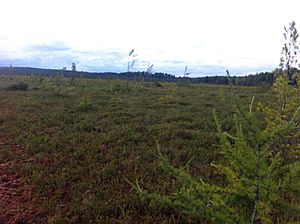Massawepie Mire facts for kids
The Massawepie Mire is a special kind of wetland called a bog. It is found in Piercefield, New York, close to Massawepie Lake. This amazing natural area covers more than 900 acres, which makes it the biggest bog in all of New York State! Its huge size comes from being located in a wide, shallow area that was carved out by glaciers long ago.
Contents
What is a Bog?
A bog is a type of wetland that gets most of its water from rain, not from rivers or groundwater. This makes the water in bogs very acidic and low in nutrients. Bogs are known for their spongy ground, which is made mostly of peat. Peat is a layer of dead plant material, like sphagnum moss, that builds up over thousands of years because it doesn't fully decay in the wet, acidic conditions.
How Bogs Form
Bogs often form in old lakes or ponds that slowly fill up with plant material. Over time, layers of moss and other plants grow and die, creating a thick mat that floats on the water or fills the basin. This process can take a very long time, making bogs like the Massawepie Mire ancient ecosystems.
Protecting the Massawepie Mire
A big part of the Massawepie Mire is located on land owned by the Massawepie Scout Camps. The scout camp works together with an organization called The Nature Conservancy. Their partnership helps to protect this important natural area and all the plants and animals that live there. Protecting the mire means keeping its unique ecosystem healthy for future generations.
Wildlife in the Mire
The Massawepie Mire is a fantastic place for birdwatching because many rare birds call it home. These birds are specially adapted to live in bog environments.
Birds of the Bog
Some of the unique birds you might find here include:
- The spruce grouse, a bird that blends in well with the forest floor.
- The Canada jay, also known as the "whiskey jack," which is very smart.
- The Lincoln's sparrow, a shy bird known for its beautiful song.
- The boreal chickadee, a small bird that lives in northern forests.
- The two-barred crossbill, a bird with a special beak for eating seeds from pine cones.
Other Animals
While birds are a highlight, the mire is also home to other creatures. Insects, amphibians, and small mammals adapted to wetland life can be found here, playing their part in the bog's delicate food web.
Plants of the Mire
The plants in the Massawepie Mire are just as special as the animals. They have learned to survive in the bog's tough conditions, where the soil is poor in nutrients.
Carnivorous Plants
Some of the most interesting plants in the mire are carnivorous plants. These plants get extra nutrients by trapping and digesting insects!
- The pitcher plants have leaves shaped like tubes or "pitchers" that collect rainwater. Insects fall into the water and can't get out.
- Sundew plants have sticky tentacles on their leaves that trap insects like flypaper.
Trees and Mosses
The bog also features unique trees and the moss that forms its base:
- Tamarack pines are unusual because they are conifers (cone-bearing trees) that lose their needles in the fall, just like deciduous trees.
- Black spruce trees are well-suited to the cold, wet conditions of the bog.
- Sphagnum moss is the most important plant in a bog. It forms a thick, spongy mat that holds a lot of water and makes the bog acidic. This moss is what creates the peat layers over time.


